Crown Hill Cemetery
Introduction
Text-to-speech Audio
Images
Crown Hill Cemetery Gateway, 1970
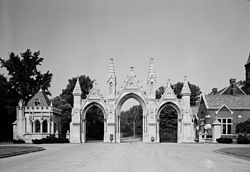
Crown Hill Cemetery
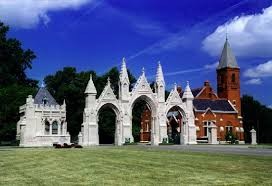
Crown Hill Cemetery
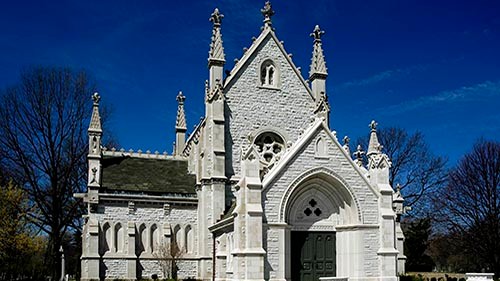
Crown Hill Cemetery
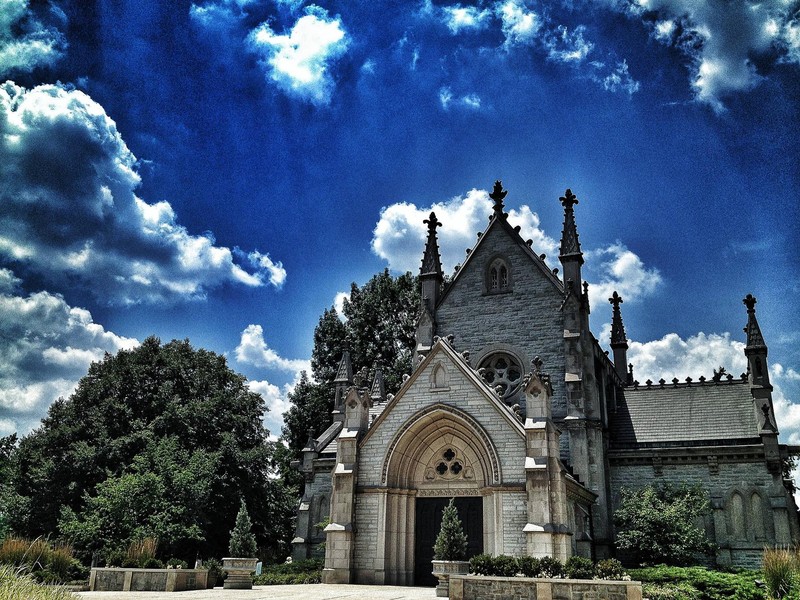
Crown Hill's famous triple-arched east entrance, located on 34th Street, was completed in 1885.
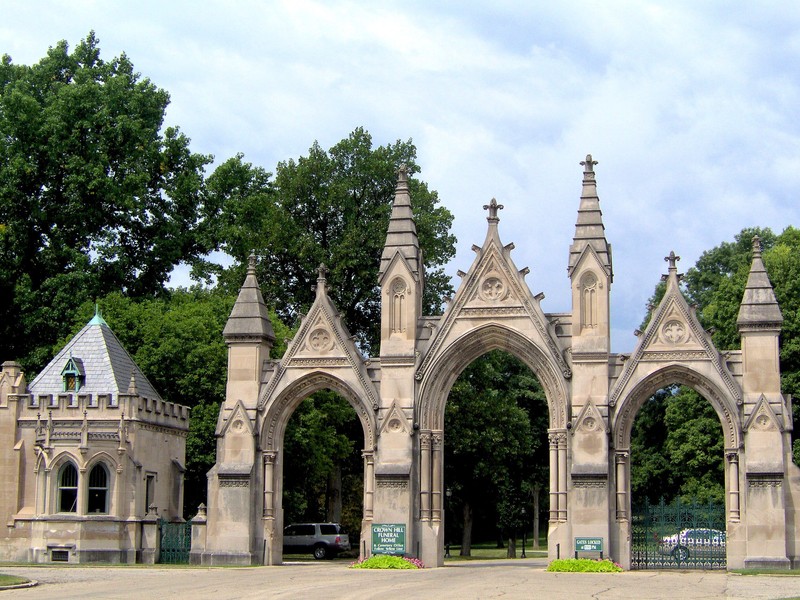
The cemetery's Gothic Chapel was designed by Diedrich Bohlen and built in 1875.
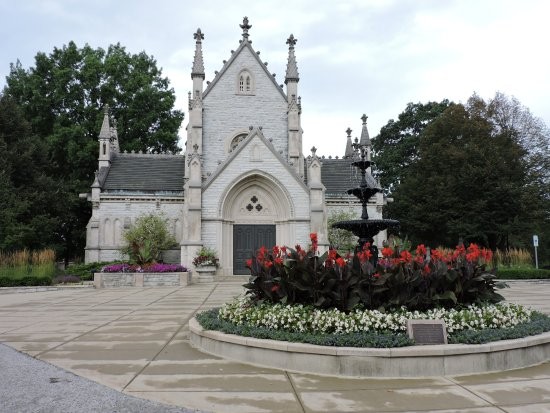
This photo shows the Indianapolis skyline behind the James Whitcomb Riley Monument.
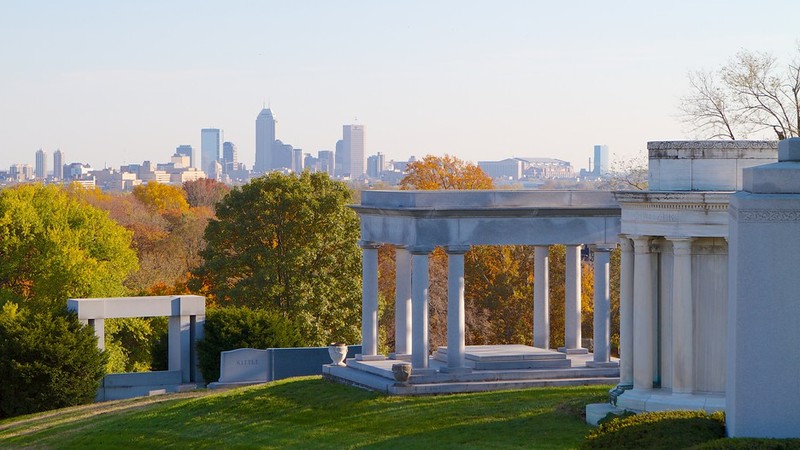
The famous Forrest Memorial was designed by Rudolf Schwarz and features a prostrate woman in elegant detail.
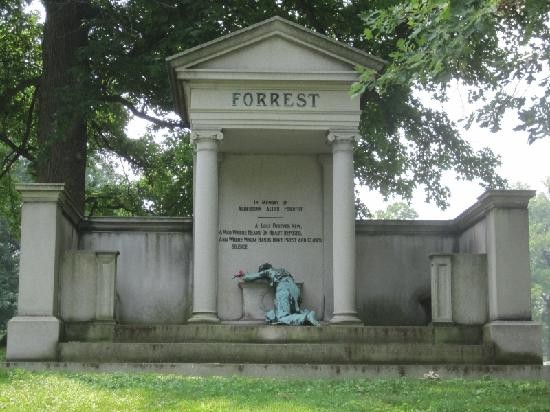
The Crown Hill National Cemetery was dedicated in 1866.

Backstory and Context
Text-to-speech Audio
The Association of Crown Hill was formed in 1863 in order to establish a new, pastoral cemetery to be located away from the city center of Indianapolis. The Association acquired a site on Strawberry Hill and hired landscape architect John Chislett and Prussian horticulturalist Adolph Strauch to design the grounds. The cemetery, which offers a panoramic view of the downtown area, was intended to offer a bucolic setting for people to escape urban life. Today, it continues to provide a place where people can stroll, picnic, and commune with nature.
Notable women who are buried at the grounds include prominent African American educator Mary Ellen Cable, U.S. Representative Julia Carson, accused murderess Nancy Clem, leading African American journalist and clubwoman Lillian Thomas Fox, Lucy Ann Seaton, and the first lady of Indiana, suffragist Zerelda Gray Wallace. See the following paragraphs for more information about their lives:
Mary Ellen Cable (Lot 234, Section 53, 1862-1944) was a prominent African American educator and activist. Cable was born in Leavenworth, Kansas and attended Leavenworth Teacher’s Normal School. She married her husband, George Cable, while she was teaching elementary school in Topeka and the couple moved to Indianapolis, where George worked in the post office. The couple had one child, Theodore, but adopted another, Mildred Orrid. As a leading Indianapolis teacher and school principal, Cable instituted an effort to teach students with tuberculosis outdoors, using a “fresh air” classroom. Cable was also a dedicated clubwoman who was involved in many civic organizations. In 1908, she helped to found the first Indiana chapter of the NAACP and served as chapter president until men became members of the chapter in 1913. An international traveler, Cable spoke to club members about her visits northern Africa in 1910 and the Middle East in 1912. In 1913, she wrote to mayoral candidate Joseph E. Bell that African American citizens had the right to access local parks, arguing that “colored folks are entitled to God’s pure air, to the bright sunlight, to the breath of flowers and the song of birds in order that life may be sweetened.” Throughout her life, Cable vigorously advocated for the rights of African Americans.[1]
Julia Carson (Section 78, Lot 172; 1938-2007) was the first women and the first African American to represent Indianapolis in the U.S. Congress. Carson graduated from the segregated Crispus Attucks High School in 1955 and also attended Martin University and Indiana University-Purdue University Indianapolis. Carson served as a member of the Indiana General Assembly for almost twenty years and spent six years as a Center Township trustee. Carson earned a reputation for empathy and frugality as a trustee, donating an apartment building near her home for use by homeless veterans and taking the public assistance program from a $20 million debt to a $6 million surplus. In 1996, Carson won a congressional seat in the U.S. House of Representatives. There she became known for her efforts regarding homelessness, financial literacy, LGBT advocacy, and the rights of women and children, as well as her successful sponsorship of a bill awarding the Congressional Gold Medal to civil rights activist Rosa Parks in 1999. Carson continued to serve until her death from lung cancer in 1997.[2]
Nancy Clem (Sec. 17, Lot 42), birthdate unknown, was an accused Indianapolis murderess who died in 1897. When the bodies of a married couple, Jacob and Nancy Jane Young, were discovered at a popular White River recreation spot on September 18, 1868, suspicion soon fell on their business partner Nancy Clem. Clem, Jacob Young, and one William J. Abrams were engaged in what historian Wendy Gamber identifies as an early example of a Ponzi scheme. Police theorized that Clem had ridden to the river with the Young’s while Silas Hartman, Clem’s somewhat disreputable brother, had followed them in a rented buggy. Hartman then shot Jacob with a shotgun procured by Abrams and Clem shot Nancy Jane with an unrecovered pistol. Clem, Abrams, and Hartman were all charged with first-degree murder. Abrams was sentenced to life in prison but received a gubernatorial pardon, while Hartman committed suicide in jail after exonerating Clem and implicating himself and Abrams. Clem became a nationally celebrated figure, depicted as what Gamber refers to as a “genteel murderess.” She underwent four trials, including one at the hands of her neighbor and future president Benjamin Harrison, before Marion County commissioners declined to fund further prosecution in 1874. After her release, Clem again engaged in financially deceptive practices and was convicted of a perjury charge in 1880, subsequently spending four years as a prisoner in the Indiana Female Reformatory. After a short illness in 1897, Clem died without delivering the deathbed confession that many hoped she would provide. Gamber argues that shifting portrayals of Clem as a woman of tenuous respectability, a “genteel murderess,” and, finally, an unrefined businesswoman exemplified the increasing social restrictions of the Gilded Age.[3]
Lillian Thomas Fox (Sec: F, Lot: 5906; 1866-1917) was a prominent African American journalist and clubwoman. She worked as the only female journalist at the African American publication Indianapolis Freeman and became the first Black woman to be hired as a fulltime journalist by a white Indiana newspaper when she joined the Indianapolis News staff in 1900. In partnership with Beulah Wright Porter, the first Black woman physician to practice in Indianapolis, Fox founded a local Colored Women’s Improvement Club (CWIC) in 1903 and expanded the organization into a state federation the following year. In 1905, Fox and the CWIC also founded Oak Hill Camp, an outdoor facility that treated Black tuberculosis patients. Fox died of a heart attack in 1917. In recognition of her accomplishments, she was inducted into the 2014 Indiana Journalism Hall of Fame.[4]
Lucy Ann Seaton (Sec. 4 Lot 28; 1831-1864) was the first person to be buried in the Crown Hill Cemetery, less than a year after its founding. Seaton died of tuberculosis shortly after moving to Indianapolis with her husband, John Seaton, a Union Captain in the Civil War. Because the family was new to the area, John published a request in the local newspaper that read “the first burial at Crown Hill Cemetery will take place today (June 2). The husband of the deceased is a stranger in this city. We hope his invitation to the public to join in the funeral will be accepted by a goodly number.” Around 200 people responded by attending the ceremony.[5]
Zerelda Gray Wallace, née Sanders (Sec. 3 Lot 10; 1817-1901) was born in Kentucky. She married David Wallace, the sixth governor of Indiana, and served as the first lady of Indiana from 1837 to 1840. Wallace was known for her work as a leading member of the Church of Crist (now the Central Christian Church of Indiana) and her support for temperance and women’s suffrage. She testified for this last cause in front of the United States Senate Committee on the Judiciary in 1880.[6]
Notable men who are buried at the grounds include former U.S. President Benjamin Harrison, Vice Presidents Charles W. Fairbanks, Thomas R. Marshall, and Thomas A. Hendricks, several Civil War generals, and Indiana poet James Whitcomb Riley, as well as Eli Lilly, notorious criminal John Dillinger and former owner of the Indianapolis Colts, Robert Irsay. Also interred at Crown Hill are numerous former governors of Indiana, U.S. senators and representatives, former mayors of Indianapolis, founders of the Indianapolis Motor Speedway, artists from the Hoosier Group, Olympic gold medalists, and Indianapolis 500 winners.
In addition, a number of both Union and Confederate soldiers are buried at Crown Hill. In 1866, the federal government purchased a 1.4-acre plot of land from the cemetery's board of directors to establish a national cemetery for Union soldiers who died in military hospitals and camps near the city. The plot cost $5,000 and the first Union soldier was re-interred at the grounds on October 19, 1866. The remains of 707 soldiers were moved from Greenlawn Cemetery to the site by the end of November 1866. It was not until December 31, 1998 that the national cemetery reached its full capacity.
Section 32 of the cemetery, also known as Confederate Mound, contains the remains of 1,616 Confederate soldiers who died while prisoners of war at Camp Morton in Indianapolis during the war. The bodies were initially interred at Greenlawn Cemetery but were transferred to Crown Hill in 1931 when a development project threatened their initial resting place. The remains were placed in a mass grave and it was not until 1993 that a memorial was constructed listing the names of those who perished at the Union prison camp.
Over the decades, the cemetery has expanded from its original 166 acres to over 550. It has added (and removed) numerous associated buildings, such as its East Gatehouse (1885), the Gothic Chapel and Vault (1875) and the Community Mausoleum, as well as numerous private mausoleums, monuments and memorials. It is also home to some historic examples of funerary art by such noted sculptors as Diedrich Bohlen, George Kessler, Rudolf Schwarz and Adolph Scherrer. The Crown Hill Heritage Foundation was established in 1984 as a non-profit organization dedicated to the preservation and promotion of the site's historic buildings and grounds. The Foundation also hosts private and public walking and driving tours of the cemetery.
Sources
Earline Rae Ferguson, “A Community Affair: African-American Women’s Club Work in Indianapolis, 1879-1917,” PhD diss., Indiana University, 1997, 33.
Will Higgins, “‘She Touched So Many’: Congresswoman remembered for her courage and humanity,” Indianapolis Star, December 23, 2007; “Long Odds Never Stopped Julia Carson,” Indianapolis Star, November 1, 2002; Rob Schneider, “She Never Forgot: Compassion for those in need grew out of her childhood experiences,” Indianapolis Star, December 16, 2007.
Wendy Gamber, “‘The Notorious Mrs. Clem’: Gender, Class, and Criminality in Gilded Age America,” The Journal of the Gilded Age and Progressive Era; Normal 11, no. 3 (July 2012): 313–43.
Earline Rae Ferguson, “A Community Affair: African-American Women’s Club Work in Indianapolis, 1879-1917,” PhD diss., Indiana University, 1997; Julie Slaymaker, “Lillian Thomas Fox - 2014,” Indiana Journalism Hall of Fame, 2014, http://mediaschool.indiana.edu/ijhf/fox-lillian-thomas; Star Library Staff, “Female columnnist was a state first,” Indianapolis Star, February 7, 2007.
Kathy Day, “Behind the gates of Crown Hill,” Indianapolis Star, September 23, 2010; John Shaughnessy, “Love, tradition prompt cemetery visits,” Indianapolis Star, May 29, 2000.
"Mrs. Zerelda G. Wallace," New York Times, March 20, 1901, Retrieved 2017-02-21; Susan Vogelsang, "Zerelda Wallace: Indiana's Conservative Radical," Traces of Indiana and Midwestern History (Indianapolis: Indiana Historical Society), Summer, 1992, 4 (3): 34–41. Douglas Wissing, Marianne Tobias, Rebecca W. Dolan; Anne Ryder, Crown Hill: History, Spirit, and Sanctuary (Indianapolis: Indiana Historical Society Press, 2013).
"A 150-Year Legacy." Crown Hill Funeral Home and Cemetery. Accessed February 21, 2017. http://www.crownhill.org/cemetery/history.html.
Browne, Tiffany. "18 Seldom Recalled Facts about Crown Hill Cemetery." Historic Indianapolis. March 24, 2012. Accessed February 21, 2017. http://historicindianapolis.com/18-seldom-recalled-facts-about-crown-hill-cemetery/.
"Crown Hill Cemetery." National Park Service. Accessed February 21, 2017. https://www.nps.gov/nr/travel/indianapolis/crownhill.html.
Day, Kathy. “Behind the gates of Crown Hill.” Indianapolis Star, September 23, 2010.
Gamber, Wendy. “‘The Notorious Mrs. Clem’: Gender, Class, and Criminality in Gilded Age America.” The Journal of the Gilded Age and Progressive Era; Normal 11, no. 3 (July 2012): 313–43. doi:http://dx.doi.org.proxygw.wrlc.org/10.1017/S1537781412000242.
Ferguson, Earline Rae. “A Community Affair: African-American Women’s Club Work in Indianapolis, 1879-1917.” PhD diss., Indiana University, 1997.
Higgins, Will. “‘She Touched So Many’: Congresswoman remembered for her courage and humanity.” Indianapolis Star, December 23, 2007.
"Historic Structures." Crown Hill Heritage foundation. Accessed February 21, 2017. http://crownhillhf.org/structures.html.
“Long Odds Never Stopped Julia Carson.” Indianapolis Star, November 1, 2002.
"Mrs. Zerelda G. Wallace". New York Times. March 20, 1901. Retrieved 2017-02-21.
Schneider, Rob. “She Never Forgot: Compassion for those in need grew out of her childhood experiences.” Indianapolis Star, December 16, 2007.
Shaughnessy, John. “Love, tradition prompt cemetery visits.” Indianapolis Star, May 29, 2000.
Slaymaker, Julie. "Fox, Lillian Thomas." Indiana Journalism Hall of Fame.
Star Library Staff. “Female columnnist was a state first.” Indianapolis Star, February 7, 2007. http://mediaschool.indiana.edu/ijhf/fox-lillian-thomas.
Vogelsang, Susan. "Zerelda Wallace: Indiana's Conservative Radical". Traces of Indiana and Midwestern History. Indianapolis: Indiana Historical Society. Summer 1992, 4 (3): 34–41.
Wissing, Douglas A., Marianne Tobias, Rebecca W. Dolan, Anne Ryder. Crown Hill: History, Spirit, and Sanctuary. Indianapolis: Indiana Historical Society Press, 2013.
Bodenhamer, David . Barrows, Robert. The Encyclopedia of Indianapolis. Bloomington, Indiana. Indiana University Press, 1994.
